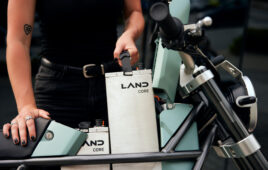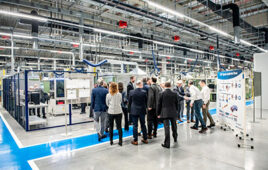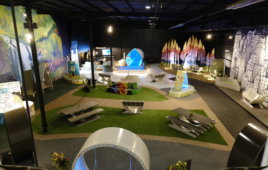 Eckes-Granini is making its packaging portfolio even more environmentally friendly with the help of the KHS Group. Since May, its one-liter hohes C juice bottle has consisted entirely of recycled plastic (rPET). KHS’ Bottles & Shapes experts in Hamburg were responsible for optimization of the bottle. The new containers will continue to be produced on the tried-and-tested InnoPET FreshSafe block. With KHS as its long-term partner, Europe’s leading fruit juice producer is making a further relevant contribution to the expansion of the circular economy. Eckes-Granini has been using 25% rPET in its hohes C PET juice bottles since 2018.
Eckes-Granini is making its packaging portfolio even more environmentally friendly with the help of the KHS Group. Since May, its one-liter hohes C juice bottle has consisted entirely of recycled plastic (rPET). KHS’ Bottles & Shapes experts in Hamburg were responsible for optimization of the bottle. The new containers will continue to be produced on the tried-and-tested InnoPET FreshSafe block. With KHS as its long-term partner, Europe’s leading fruit juice producer is making a further relevant contribution to the expansion of the circular economy. Eckes-Granini has been using 25% rPET in its hohes C PET juice bottles since 2018.
“Bearing the EU’s plastic strategy in mind and the increase in recyclate quotas this prescribes, we’ve now decided to switch to using recycled PET only. We want to be a pioneer as regards the circular economy and set a good example for the beverage industry,” said Hermann Naumann, plant manager for Eckes-Granini in Bad Fallingbostel, Germany. “We aim to continue steadily reducing our carbon footprint in production and in our packaging. This means not only cutting down on the amount of material used but also closing the recycling loop.”
In Germany, beverage producers state their preferences regarding the weight, shape or stability of the container — and then, the systems supplier assesses the feasibility of the design through laboratory tests and simulation. For Eckes-Granini, the specifications were clear: switch to 100% rPET while maintaining the homogeneous quality of the container. According to the company, the changeover of the one-liter hohes C bottle to rPET will save more than 4,000 metric tons of new PET per annum. This, in turn, means that the bottler will cut its carbon emissions by about 8,000 tons a year.
Finding ways of saving on resources was not the only focus of the ambitious project. The ability to do so on the KHS InnoPET FreshSafe block in operation at Eckes-Granini since 2017 also had to be investigated.
“One of the concerns was whether either the preforms or machine needed adapting,” said Dr. Matthias Kruse, head of PET Technology at KHS. “We thus assessed the quality of the recycled PET material. This is crucial, for large variances in color, molecular length and inhomogeneity quickly reduce the efficiency of production.”
The fact that Eckes-Granini procures its preforms from two different suppliers presented an added challenge, Kruse said. The geometry of the preform is essential for efficient processing, especially when a high percentage of rPET is used. Through extensive testing, it was established that both makes of preform function soundly on the block system. All that was needed for optimum bottle production were minor adjustments to the heater on the stretch blow molder.
KHS’ NIR or near infrared technology especially provides a wide processing window for rPET, allowing preforms to be heated prior to the stretch blow molding process with pinpoint accuracy, for example. No major changes to the machinery or geometrical properties of the preforms were required.
“This enabled us to achieve a very high level of process efficiency while retaining the container quality, thus fully meeting our customer’s requirements,” Kruse said.
Eckes-Granini will continue to benefit from FreshSafe PET barrier protection also after converting to 100% rPET. The company has relied on the environmentally friendly system from KHS since 2006. The oxygen barrier of chemically pure glass, a wafer-thin coating on the inside of the PET bottle, not only effectively protects the juice from oxygen pickup, but is also fully recyclable. What’s more, the coating can be easily washed off bottles during the recycling process. The sustainable packaging alternative therefore permits pure-grade bottle-to-bottle recycling.
By the end of 2022 Eckes-Granini Deutschland intends to only use PET bottles made entirely of rPET for all brands, saving approximately 9,000 metric tons of new plastic per year by doing so.
KHS
www.khs.com
Filed Under: Green engineering • renewable energy • sustainability




